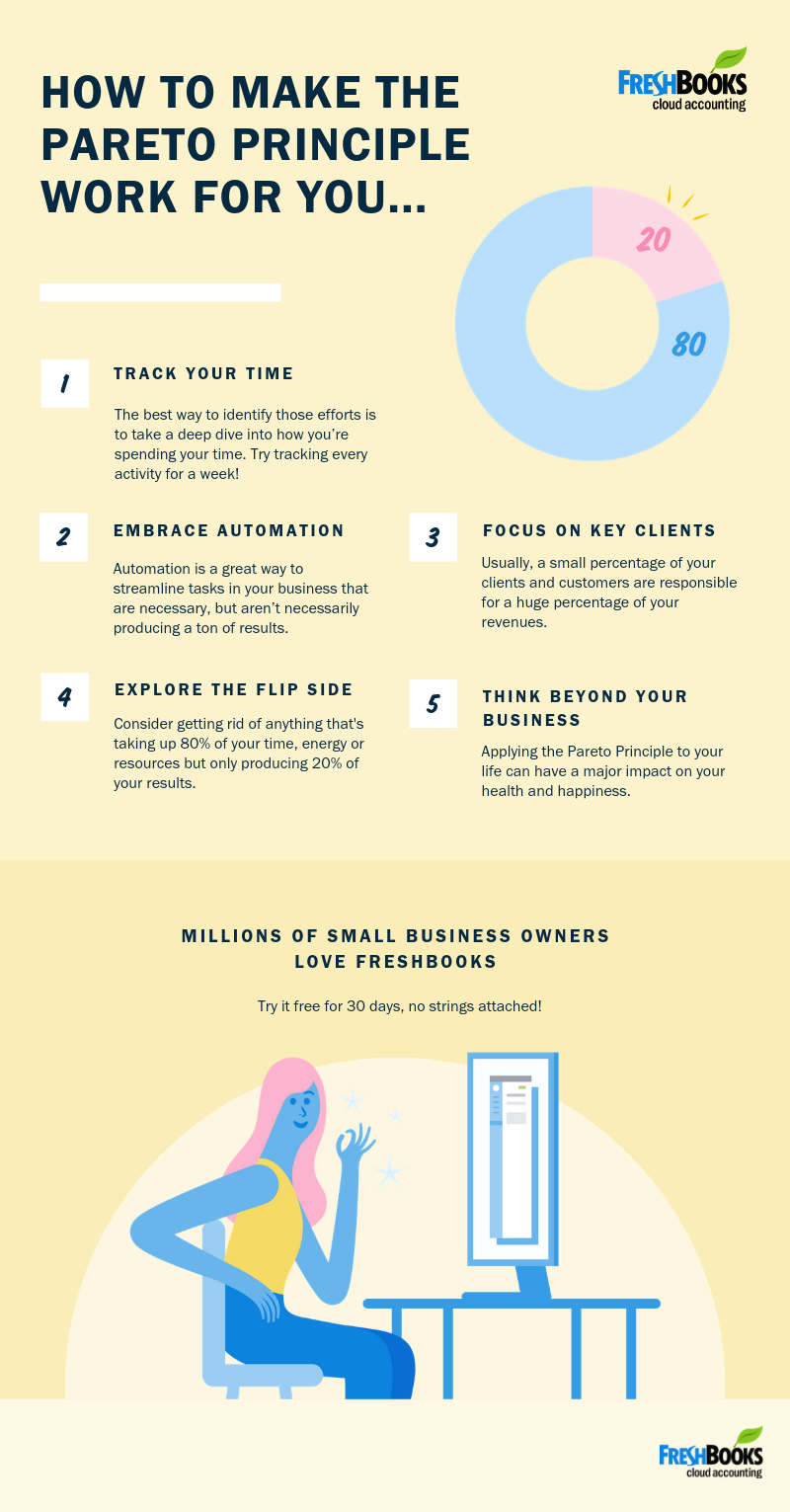When you understand the Pareto principle (a.k.a. the 80/20 rule), you can use it to get more done—with less effort.

As a small business owner, you wear a ton of different hats, from administrator to accountant to head of business development (and every hat in between!). With so many conflicting demands and priorities, it can be hard to stay on top of your tasks and get things done without feeling completely overwhelmed. That’s where the Pareto principle comes in.
When you understand and apply this productivity principle, you can get more done with less effort—and skyrocket your productivity without the side of stress. But what, exactly, is the Pareto principle? How does it impact productivity? And how can you apply this principle to your business (and life!) to take your productivity to the next level?
Table of Contents
What Is the Pareto Principle?
Before we jump into how the Pareto principle can transform your business, let’s first cover what the Pareto principle actually is.
The Pareto principle (a.k.a. the 80/20 rule) dates all the way back to 1906 when famed Italian economist Vilfredo Pareto observed that 80% of Italy’s land and wealth was owned by 20% of its population.
The Pareto principle, or 80/20 rule, states: 80% of outcomes are driven by 20% of efforts.
Over time, the 80/20 distribution was observed in a variety of circumstances, and eventually, the Pareto principle evolved to become today’s more general definition of 80% of outcomes are driven by 20% of efforts.
Now, keep in mind, it’s not the exact statistic that matters and the ratio might change in different circumstances (so, for example, you might find that in a certain situation, the balance is 75/25 or 90/10). The most important thing to note in the Pareto principle is that there’s usually a pretty significant imbalance between effort and results.
Understanding the 80/20 Rule—and How It Impacts Productivity
So, according to the Pareto principle, 80% of your results are being driven by 20% of your efforts. But what, exactly, does that have to do with productivity?
When you understand that the vast majority of your results are being driven by a small percentage of your efforts, you can pinpoint which efforts are driving the most results in your business (and life!)—and focus your energy on those.
So, for example, let’s say you have a client roster that’s a mile long. But after a little Pareto-inspired research, you realize that 80% of your revenues are coming from just five clients. You could get more done and drive more revenue if you focused your time and energy on those five clients, instead of running yourself into the ground trying to manage your 25+ client list (and getting completely overwhelmed in the process).
The point is, the 80/20 rule allows you to maximize your efforts, making sure that everything you do is driving the highest level of results. And just as importantly, it allows you to identify where you’re spinning your wheels without getting results, so you can let those tasks go and put your time and energy into what’s actually working for you.
Examples of the Pareto Principle in Action
Still not sure how the Pareto principle applies to you and your business? There are a myriad of ways the Pareto principle can play out in small and midsize businesses (SMBs), for example:
- 80% of your new customer acquisitions may come from 20% of your discovery calls
- 80% of your leads may come from 20% of your lead generation sources
- 80% of your sales may come from 20% of your sales team
- 80% of your revenue may come from 20% of your customers and/or clients
With the 80/20 rule, there are no hard and fast rules; the way the Pareto principle plays out in your business is going to depend on your systems, your products or services, your customers and the other factors that make your business unique. But no matter how unique your business may be, we promise if you look hard enough, you’ll see the 80/20 rule at play in various areas of your operations.
How Adopting an 80/20 Mindset Can Change Your Business—and Your Life
You know what the Pareto principle is. You know how it impacts productivity and some of the ways it may play out in your business operations. But how, exactly, can putting the Pareto principle to work in your business (and your life!) create positive and productive change?
There are so many ways the 80/20 rule can transform your business, including:
- Less stress. When you’re spending a ton of time working on tasks that don’t produce any real results, you’re eventually going to start to feel overwhelmed (or, even worse, burned-out). Applying the 80/20 rule allows you to hone in on the tasks that are having a real impact on your business, focus your time and energy on those tasks and get more done with less effort. It’s like an antidote for stress!
- Higher level of engagement with your work. In addition to making you feel overwhelmed, spending a ton of time and energy on tasks that aren’t working for you can also make you feel bored, frustrated and disengaged with your work. When you apply the 80/20 rule to your business, you spend more of your time on the tasks that really matter, which can lead to more enjoyment of and engagement with your work.
- More time for passions outside of work. As mentioned, the Pareto principle allows you to get more done with less effort. This frees up more time and energy in your life—time and energy you can use to pursue your passions outside of work (like spending time with your family or exploring new hobbies).
Bottom line? Adopting the 80/20 rule can completely transform your business (and, in many ways, your life).
5 Ways to Make the Pareto Principle Work for You
Clearly, the Pareto principle is a powerful tool for increasing productivity and transforming your business. But how do you put it into action? How can you take the 80/20 rule from “business principle” to “actually working in your business?”
Here are a few strategies you can use to make the Pareto principle work for you:
1. Track Your Time
The only way the 80/20 rule works is if you can accurately identify which 20% of your efforts are producing 80% of your results (and, potentially more importantly, which 80% of your efforts aren’t really working for you). And the best way to identify those efforts is to take a deep dive into how you’re spending your time.
Doing a time inventory can help you get a clear picture of how you’re spending your time every day—and, more importantly, which of your daily tasks are producing results.
So, how do you do a time inventory?
For one week, track how you’re spending every minute of your day, both in and out of work. You can use a time tracking tool like FreshBooks or if you want to keep things old-school, you can just keep track using a pen and notebook. It’s not important how you track your time. What’s important is that you track where every minute is going.
Did you spend 10 minutes in between meetings scrolling through Instagram? Log it. Did you spend your entire morning on client calls? Log it. Did you get stuck with hours of laundry, spend an hour clearing out your inbox or hit the gym for a midday workout? Log it, log it, log it.
After a full week of tracking your time, you’ll have an accurate outline of where your time is going (if you do your time inventory using a time tracking tool, you can actually visualize where your time is going via different charts and graphs). And once you have that? It becomes much easier to identify what is time well spent (the 20%)—and what is time wasted (the 80%).
2. Embrace Automation
When you finish your time inventory and examine how you’re spending your time, chances are, you’re going to identify some tasks that you can’t exactly eliminate but also aren’t exactly producing results.
And for those tasks, the best thing you can do? Embrace automation.
Automation is a great way to streamline tasks in your business that are necessary but aren’t necessarily producing a ton of results. So, let’s use invoicing as an example. Invoicing is a necessity in any business; you have to invoice your clients if you want to get paid. But spending 10+ hours a week manually invoicing every client isn’t exactly a good use of your time and it’s not going to produce any real results.
That’s where automation comes in. Instead of wasting hours every week on the invoicing process, you can use an accounting tool like FreshBooks to automate the process of sending invoices, tracking payments and keeping the financials of your business in order. Then, you can take back the time you were spending on invoicing and focus it on the areas of your business (the 20%) that are producing results.
3. Focus on a Few Key Clients
As mentioned in the earlier example, oftentimes, a small percentage of your clients and customers are responsible for a huge percentage of your revenue. So, if you want to drive more revenue and take your business to the next level, you need to identify those clients or customers and stick with them.
Take a deep dive into your finances. Where is the majority of your revenue coming from? Narrow down your client or customer list so you’re focusing your time and efforts on the people who are producing real results for your business.
Not only will this make your business easier to manage, but it’s likely to increase revenue. You’re much more likely to drive revenue by providing a higher level of service to clients and customers who are already spending money than by spinning your wheels with the other 80% that aren’t contributing to your bottom line in a significant way.
4. Remember: The Flip Side of the 80/20 Rule Is Also True
So, the Pareto principle says that 20% of your efforts produce 80% of your results. But the flip side of that can also be true!
If there’s something in your business that’s taking up 80% of your time, energy or resources but is only producing 20% of your results (like a difficult client), get rid of it! Spending time and energy on these tasks in your business will not only cause a serious drop in productivity but can also be a one-way ticket to burnout.
5. Think Outside of the Business Box
The Pareto principle is an extremely powerful tool for transforming your business. But the 80/20 rule isn’t just for business, and applying it in your life can have a major impact on your health and happiness.
Dig into how the 80/20 ratio is at work in your life. What 20% of your day is producing 80% of your joy? What 20% of your activities are producing 80% of your energy? What 20% of your friends and family are producing 80% of the love and support in your life?
Applying the Pareto principle to other areas of your life helps you identify what’s important and where you should be focusing your attention.
Use the 80/20 Rule to Take Your Business to the Next Level
We all have a limited amount of time, energy and resources to invest. But with the 80/20 rule, you can make sure that the way you’re spending your time, energy and resources is delivering the highest return on your investment.
This post was updated in September 2019.

Written by Deanna deBara, Freelance Contributor
Posted on January 29, 2020
 How I Improved My Productivity with the 50-Minute Focus Technique
How I Improved My Productivity with the 50-Minute Focus Technique Would You Adopt a 32 Hour Workweek?
Would You Adopt a 32 Hour Workweek?




